
Senecio is a genus of flowering plants in the daisy family (Asteraceae) that includes ragworts and groundsels.

Senecioneae is the largest tribe of the Asteraceae, or the sunflower family, comprising over 150 genera and over 3,500 species. Almost one-third of the species in this tribe are placed in the genus Senecio. Its members exhibit probably the widest possible range of form to be found in the entire plant kingdom, and include annuals, minute creeping alpines, herbaceous and evergreen perennials, shrubs, climbers, succulents, trees, and semi-aquatic plants.

Craspedia is a genus of flowering plants in the family Asteraceae commonly known as billy buttons and woollyheads. They are native to Australia and New Zealand where they grow in a variety of habitats from sea level to the Alps. The genus is found in every state of Australia but not in the Northern Territory. In New Zealand, Craspedia is found from East Cape on the North Island south to Stewart Island. It also occurs on Campbell Island and the Chatham Islands.

Olearia, most commonly known as daisy-bush, is a genus of flowering plants belonging to the family Asteraceae, the largest of the flowering plant families in the world. Olearia are found in Australia, New Guinea and New Zealand. The genus includes herbaceous plants, shrubs and small trees. The latter are unusual among the Asteraceae and are called tree daisies in New Zealand. All bear the familiar daisy-like composite flowerheads in white, pink, mauve or purple.

Bedfordia is a genus of flowering plants belonging to the family Asteraceae. The genus includes 3 species, all endemic to Australia.

Brachyglottis is a genus of flowering plants in the family Asteraceae. The genus was erected on November 29, 1775, by Johann Reinhold Forster and Georg Forster. The name was derived from the Greek brachus ("short") and glottis a reference to the size of the ray florets.

Erechtites is a genus of flowering plants in the daisy family known commonly as fireweeds or burnweeds. They are native to the Americas and Australia, but some species are widely distributed weeds.

Senecio tamoides, also known as Canary creeper, false grapevine, and parlor ivy, is a climbing member of the genus Senecio of the family Asteraceae that is native to Southern Africa. It is used as an ornamental plant for its showy yellow, daisy-like flowers in late autumn through to winter.
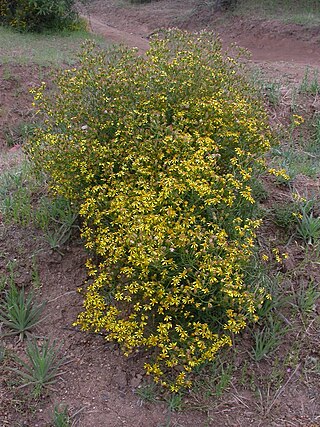
Senecio invalidus is a species of the genus Senecio and family Asteraceae.

Senecio pinnatifolius is a species of herb native to Australia. Common names include coast groundsel, dune groundsel and variable groundsel.
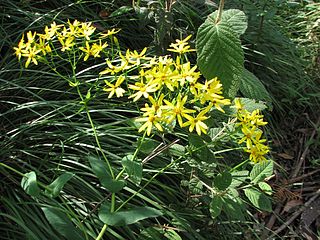
Lordhowea velleioides, synonym Senecio velleioides, is a species of flowering plant in the family Asteraceae. It is commonly known as forest groundsel.
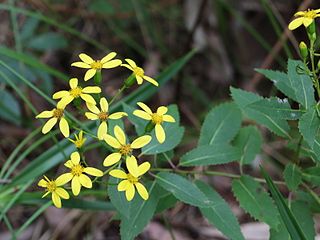
Lordhowea amygdalifolia, synonym Senecio amygdalifolius, is a species of flowering plant in the daisy family (Asteraceae). It occurs in the Australian states of New South Wales and Queensland, in wet eucalyptus forest or around the margins of rainforest. Ferdinand von Mueller first described it in 1859, as Senecio amygdalifolius, from a collection made by Dr. Hermann Beckler, near the Hastings River.

Senecio garlandii, commonly known as woolly ragwort, is a species of daisy native to southern New South Wales and north-eastern Victoria.

Caputia is a small genus of flowering plants in the family Asteraceae, native to South Africa. It may be of hybrid origin. Species in this genus were formerly considered part of the genus Senecio.
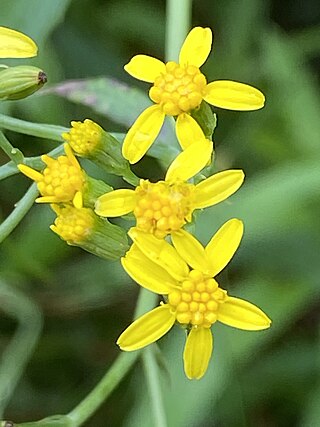
Senecio linearifolius, commonly known as fireweed groundsel, is a species of flowering plant in the family Asteraceae. It is a small shrub with variable leaves, numerous heads of yellow flowers and grows in Tasmania, New South Wales and Victoria.

Senecio vagus, commonly known as saw groundsel, is a species of flowering plant in the daisy family Asteraceae. This plant occurs in the Australian states of New South Wales, Victoria and Tasmania. An erect perennial herbaceous plant, growing up to 1.5 metres tall. Mostly seen in moist gullies on the Great Dividing Range. Yellow flowers usually form in spring and summer. The lectotype was collected in the Dandenong Ranges in 1853 by Ferdinand von Mueller.
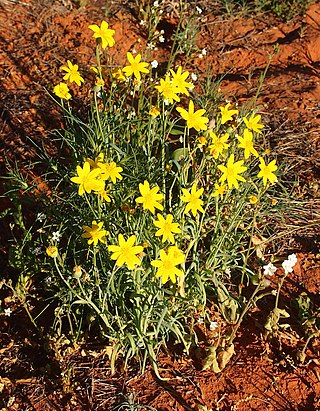
Senecio gregorii, commonly known as annual yellowtop or fleshy groundsel, is a native Australian wildflower species, found in arid and semi-arid regions of the Australia and across the globe. It often grows prolifically after autumn/winter rains, showcasing stunning yellow flowers and fleshy foliage. The scientific name of this species was first published by Ferdinand von Mueller.
Carex cephalotes, also known as wire-head sedge, is a tussock-forming species of perennial sedge in the family Cyperaceae. It is native to south eastern Australia and New Zealand.

Lordhowea is a genus of flowering plant in the family Asteraceae, native to eastern and south-eastern Australia and Lord Howe Island. The genus was established by Bertil Nordenstam in 1978.
Scapisenecio is a genus of flowering plant in the family Asteraceae, native to south-eastern Australia, particularly Tasmania. The genus was established in 2020.

















